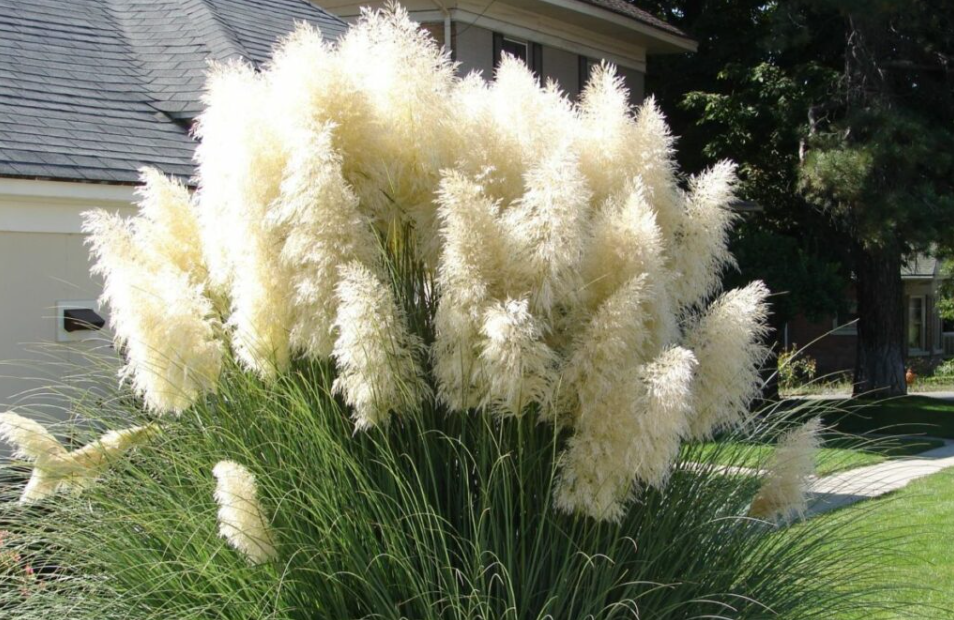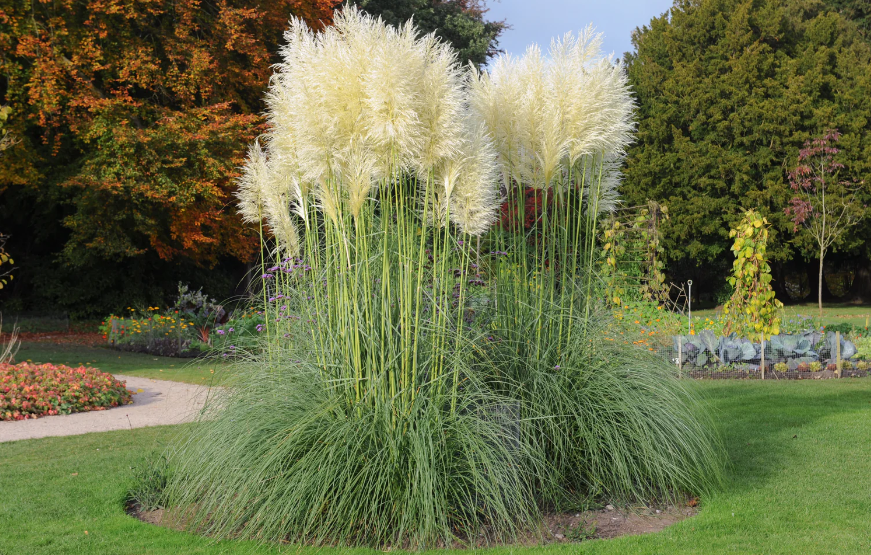
Pampas grass is an evergreen ornamental grass that grows wild in its native to southern South America, particularly the Pampas region, Brazil, Argentina and Chile. It’s characterized by tall, reed-like appearance and feathery plumes, which can be either white or pink.
It was introduced to Europe and North America in the 19th century and has since become a common garden plant in temperate regions. This grass can live for several years and can grow up to 10 feet tall and 6-10 feet wide. It is hardy in U.S. Department of Agriculture plant hardiness zones 8 through 10. It is also still one of the most frequently planted ornamental grass variety worldwide.
Pampas grass grows to a height of 8 to 12 feet and clumps can get as wide as 6 feet. It grows in a clumping habit, and it naturalizes easily where conditions are favorable. If tall flower plumes are left on the stalk, the plant will readily self-seed.
The silver white plumes, sometimes tinted pink, are the flowers or inflorescences of this grass plant. The fluffy dense panicles reach 1 to 4 feet long, increasing the overall height of the pampas grass clump. The plumes produce a fountain-like shape and appear from fall through late winter. Both male and female plants produce the tall, slender stalks topped with plumes, but the female flowers are fuller.
During the winter, the feathers and foliage of plants in freezing climates will turn golden brown, which is attractive to some. In frost-free climates, the foliage will remain green. In time, the old feathers will gradually shed all of their plumes, leaving tall stalks poking up above the leaves.
This grass has ability to grow in areas where other plants cannot. It is fast-growing and can form large masses along the roads, cliffs, riverbanks, and open areas that have been disturbed by human activities or natural disturbances. Pampas grass can displace native plants and destroy their habitats, reducing biodiversity. It is considered invasive in some areas such as California, Hawaii, Texas, Oregon, and Washington, and it’s not recommended for planting in those regions.
In United States, there are two main species of pampas grass: Cortaderia selloana and Cortaderia jubata. C. selloana is the more common ornamental variety, while C. jubata is the one considered invasive weed in some areas. The two species are often confused, leading to concerns about the spread of invasive pampas grass.
Other varieties include: Cortaderia richardii and Cortaderia rudiuscula.
- Cortaderia richardii: is native to New Zealand and is commonly known as “toe toe grass.” It is smaller than the other species of pampas grass, reaching a height of only 4 to 6 feet.
- Cortaderia rudiuscula: is also native to New Zealand and is known for its attractive, reddish-brown plumes. It is a smaller plant, growing to a height of 3 to 4 feet.
Because of its tall size, pampas grass is suitable to large landscapes and makes a good statement piece. Its height and thickness make it a good choice for a screen plant. It is evergreen, so it adds winter color to the garden. As it is highly tolerant of salt, it is also a good seaside plant. Its tall flowers, sometimes as long as 3 feet, may be cut and dried for use in arrangements.
In cultivation, Pampas grass can live for up to 10-15 years with proper care. However, in some places where its growing wild, it may live longer than 15 years. The down side of growing this plant is that it can become a fire hazard when the old foliage dies and becomes dry. The dried leaves and stalks are highly flammable.
Growing Pampas Grass

Pampas grass can tolerate light shade, but like turf grass it grows best in full sunlight. Reduced light deprives the grass of normal growth processes. It becomes less resistant to disease, and it has to compete with larger plants for water and nutrients. Ideally, pampas grass should be planted as a border or background by itself or with others of its kind, but nothing taller.
Choose a location that receives as much light as possible. Although it is drought-tolerant once established, pampas grass needs considerable moisture while getting established. Plant it in well-drained, amended soil that will conserve and evenly distribute water. When growing them together, space plants 10 feet apart so they have room to expand without crowding one another out. To keep it looking nice, comb dead leaves out of the clump with a pitchfork.
The best time to trim pampas grass is late winter or early spring, just before new growth begins. This timing ensures that you don’t damage any new growth and allows the plant to recover quickly. Start by cutting the pampas grass back to about 6 to 12 inches from the ground. This can be done using the pruning shears for thinner stems and the pruning saw for thicker ones.
How to Transplant Pampas Grass
- Water the clump thoroughly with an inch or two of water to hydrate the roots on the day before you plan to transplant. This helps keep the roots from drying out after they are lifted from the ground and makes the soil easier to work.
- Cut dried blades and stalks down to 12 inches with handheld or powered hedge clippers. A string trimmer also will work.
- Cut a circle around the plant the full depth of the shovel blade. Divide the clump into more manageable sections, if needed, by cutting it into quarters with the shovel.
- Remove each section by digging under it and rocking it with the shovel. Move around the section with the shovel until the pampas grass loosens and can be pried out of the ground. Each section is now a new clump you can transplant or give to a friend.
- Dig a new home in a sunny, well-drained location for each new clump. The hole should be as deep as and 1 1/2 times as wide as the clump. Amend some of the soil with one-third garden compost or composted manure.
- Place each section in its hole and wiggle it so it makes good contact with the soil. Backfill with the improved soil, tamping it gently with your shoe. Make sure the clumps are at the same level they were in the old location.
- Thoroughly water the newly planted clump and the soil around it. This settles the soil around the plant and re-hydrates the roots.
- Cover the soil around the plant with an inch or two of mulch, such as shredded bark, to conserve moisture.
How to Kill Pampas Grass
- Cutting: Start by cutting the pampas grass as close to the ground as possible using a sharp pair of pruning shears or a weed whacker. This will make it easier to apply herbicides or other treatments.
- Herbicides: Glyphosate and imazapyr are two common herbicides that can be effective in killing pampas grass. Apply the herbicide directly to the cut stems and leaves of the pampas grass, being careful to avoid getting it on any nearby plants.
- Solarization: This method involves covering the pampas grass with a plastic sheet to trap heat and kill the plant. To do this, cut the pampas grass down to the ground, then cover it with a clear plastic sheet. Secure the edges of the sheet with rocks or stakes to prevent air from getting under the sheet. Leave the sheet in place for several weeks to allow the heat to build up and kill the pampas grass.
- Smothering: Smother the pampas grass with a thick layer of mulch or cardboard. Cut the pampas grass down as close to the ground as possible, then cover it with several inches of mulch or cardboard. This will block out sunlight and prevent the pampas grass from growing.
- Digging: For smaller patches of pampas grass, digging up the roots can be an effective way to get rid of the plant. Use a shovel or garden fork to dig up the entire root system, being careful to remove all of the roots to prevent the pampas grass from growing back.
- Burning: In some areas, it may be legal to burn pampas grass to get rid of it. However, this method should only be used with extreme caution and with the proper permits and safety precautions in place.
Alternatives of Pampas Grass
| Alternative Name | Scientific Name | Description |
|---|---|---|
| Feather Reed Grass | Calamagrostis x acutiflora | Similar in appearance to Pampas Grass but with narrower, more upright plumes. Tolerant of different soil and climate conditions. |
| Fountain Grass | Pennisetum spp. | Has arching foliage and bottlebrush-like flower spikes. Has many cultivars with different colors and sizes. |
| Maiden Grass | Miscanthus sinensis | Features tall, upright growth with feathery plumes that emerge in late summer. |
| Ravenna Grass | Saccharum ravennae | Has large, fluffy plumes. |
| Blue Fescue | Festuca glauca | A low-growing grass with blue foliage. |
| Switchgrass | Panicum virgatum | Native to North America, Switchgrass has upright growth and airy flower panicles. Drought-tolerant once established. |
| Little Bluestem | Schizachyrium scoparium | A native prairie grass, it has blue-green foliage that turns reddish-brown in autumn. |
| Zebra Grass | Miscanthus sinensis ‘Zebrinus’ | Has horizontal stripes on the foliage. |
| Karl Foerster Feather Grass | Calamagrostis x acutiflora ‘Karl Foerster’ | A cultivar of Feather Reed Grass with tall, narrow plumes that persist throughout the winter. |
| Ribbon Grass | Phalaris arundinacea | Features variegated foliage with green and white stripes. Can be invasive in some regions, so plant with caution. |
| Purple Moor Grass | Molinia caerulea subsp. caerulea | Has purple-hued foliage and airy flowerheads. |
| Japanese Silver Grass | Miscanthus sinensis | Has a number of cultivars with different sizes, colors, and growth habits. |